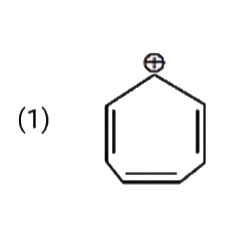Which is the decreasing order of stability
(i) CH3−+CH−CH3
(ii) CH3−+CH−O−CH3
(iii) CH3−+CH−CO−CH3
(i)<(ii)<(iii)
(i)>(ii)>(iii)
(iii)>(ii)>(i)
(ii)>(iii)>(i)
The correct Answer is:B
To determine the decreasing order of stability for the given carbocations, we need to analyze the effects of substituents on the stability of each carbocation. The stability of carbocations is influenced by the inductive effect and resonance effect of the groups attached to the positively charged carbon atom.
1. Identify the Carbocations:
- (i) CH3−CH±CH3 (Isopropyl carbocation)
- (ii) CH3−CH±O−CH3 (Methoxy carbocation)
- (iii) CH3−CH±CO−CH3 (Acetyl carbocation)
2. Analyze the Isopropyl Carbocation (i):
- The isopropyl carbocation has three alpha hydrogen atoms and is stabilized by hyperconjugation and the +I (inductive) effect from the adjacent methyl groups.
- The positive charge is effectively shared due to the presence of the three adjacent hydrogen atoms.
- Conclusion: This carbocation is quite stable.
3. Analyze the Methoxy Carbocation (ii):
- The methoxy group (-OCH3) has both a +R (resonance) effect and a -I (inductive) effect.
- The +R effect can help stabilize the positive charge through resonance, while the -I effect can destabilize it by pulling electron density away.
- The presence of three alpha hydrogen atoms also contributes to stability, but the -I effect of the methoxy group reduces the overall stability.
- Conclusion: This carbocation is less stable than the isopropyl carbocation but more stable than the acetyl carbocation.
4. Analyze the Acetyl Carbocation (iii):
- The acetyl group (-COCH3) has a strong -I effect and also a -R effect due to the carbonyl group.
- This means that it pulls electron density away from the positively charged carbon, significantly destabilizing the carbocation.
- There are also three alpha hydrogen atoms, but the strong electron-withdrawing effects dominate.
- Conclusion: This carbocation is the least stable among the three.
5. Final Stability Order:
- Based on the analysis, the decreasing order of stability is:
- (i) Isopropyl carbocation > (ii) Methoxy carbocation > (iii) Acetyl carbocation.
Final Answer:
The decreasing order of stability is:
(i) > (ii) > (iii)
- (i) CH3−CH±CH3 (Isopropyl carbocation)
- (ii) CH3−CH±O−CH3 (Methoxy carbocation)
- (iii) CH3−CH±CO−CH3 (Acetyl carbocation)
- The isopropyl carbocation has three alpha hydrogen atoms and is stabilized by hyperconjugation and the +I (inductive) effect from the adjacent methyl groups.
- The positive charge is effectively shared due to the presence of the three adjacent hydrogen atoms.
- Conclusion: This carbocation is quite stable.
- The methoxy group (-OCH3) has both a +R (resonance) effect and a -I (inductive) effect.
- The +R effect can help stabilize the positive charge through resonance, while the -I effect can destabilize it by pulling electron density away.
- The presence of three alpha hydrogen atoms also contributes to stability, but the -I effect of the methoxy group reduces the overall stability.
- Conclusion: This carbocation is less stable than the isopropyl carbocation but more stable than the acetyl carbocation.
- The acetyl group (-COCH3) has a strong -I effect and also a -R effect due to the carbonyl group.
- This means that it pulls electron density away from the positively charged carbon, significantly destabilizing the carbocation.
- There are also three alpha hydrogen atoms, but the strong electron-withdrawing effects dominate.
- Conclusion: This carbocation is the least stable among the three.
- Based on the analysis, the decreasing order of stability is:
- (i) Isopropyl carbocation > (ii) Methoxy carbocation > (iii) Acetyl carbocation.
The decreasing order of stability is:
(i) > (ii) > (iii)
Topper's Solved these Questions
- GENERAL ORGANIC CHEMISTRYBOOK - ERRORLESS CHAPTER - GENERAL ORGANIC CHEMISTRYEXERCISE - JEE Section (More than one choice correct answer)
32 Videos
- GENERAL ORGANIC CHEMISTRYBOOK - ERRORLESS CHAPTER - GENERAL ORGANIC CHEMISTRYEXERCISE - Reasoning type questions
5 Videos
- GENERAL ORGANIC CHEMISTRYBOOK - ERRORLESS CHAPTER - GENERAL ORGANIC CHEMISTRYEXERCISE - Critical Thinking (Objective Questions)
44 Videos
- GASEOUS STATE BOOK - ERRORLESS CHAPTER - GASEOUS STATE EXERCISE - JEE SECTION JEE (Advanced) 2018 Numeric answer type question
1 Videos
- HALOGEN CONTAINING COMPOUNDBOOK - ERRORLESS CHAPTER - HALOGEN CONTAINING COMPOUNDEXERCISE - Critical Thinking (Jee (Advanced) 2018)
1 Videos
Similar Questions
Knowledge Check
Which is the decreasing order of stability
(a). CH3−+CH−CH3
(b). CH3−+CH−O−CH3
(c). CH3_+CH−CO−CH3AagtcgtbBagtbgtcCcgtbgtaDbgtagtcArrange following carbocation in the decreasing order of stability
(i) CH3−+CH−CH3
(ii) CH3−+CH−O−CH3
(iii) CH3−+CH−CO−CH3A(iii)>(ii)>(i)B(i)>(ii)>(iii)C(i)>(ii)>(iii)D(i)<(ii)<(iii)The order of decreasing stability of the cations is :
(I) CH3+CHCH3 , (II) CH2+CHOCH3 , (III) CH3+CHCOCH3AIII>II>IBI>II>IIICII>I>IIIDI>III>II
The correct decreasing order of stability of I,II and III carbocations is:
(I) CH3−+CH−CH3 (II) CH3−+CH−COCH3
(III) CH3−+CH−OCH3
View SolutionArrange the following in decreasing order of their stability :- (I)CH3−⊕CH2 (II)CH3−⊕CH∣CH3
(III)CH3−CH3∣C⊕−CH3 (IV)CH2−⊕CH2∣F
View SolutionThe stability of given free radicals in decreasing order is
(i) CH3−.CH2 , (ii) CH3−C.H−CH3
(iii) CH3−.C∣CH3−CH3, (iv) .CH3
View SolutionIn the following compunds the decreasing order of B.P. is
(i) CH3−CH2−CH2−CH2−CH2−CH3
(ii) CH3−CH3∣CH−CH2−CH2−CH3
(iii) CH3−CH3∣C∣CH3−CH2−CH3
View SolutionArrange the following compound is decreasing order of macheophillic addection reation
(I) CH3−O∣∣C−CH3 (II) CH3−O∣∣C−CI (III) CH3−O∣∣C−NH2
(Iv) CH3−O∣∣C−OH (V) CH3−O∣∣C−O−O∣∣C−CH3
View Solution

